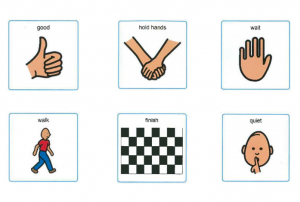Being aware of our voices while talking with our children is helpful, especially at busy times when we need to give directions to help them move on to the next stage of the day.
By using a calm voice you can:
- Help your child learn to respond to you in a positive way
- Provide a positive model for your child as to how to communicate with other
Some tips for positive, effective communication when you are giving a direction:
- Get down to your child’s eye level
- Try to have your child’s attention before speaking. You might do this by:
- being face to face with your child
- holding your child’s hand
- showing a visual support – an object or picture – to support what you want to say. for example, if you are going in the car you could show your car keys
- Using a keyword sign
- Use a soft, calm but firm voice
- Tell your child what you want them to do, rather than what you don’t want them to do. For example, “Walk to the car,” rather than “Don’t run to the car”
- Try to minimise using words like “no” and “don’t” repeatedly, as they tend to have limited effect if overused
- Give your child time to respond and co-operate. Try to wait for 5 to 10 seconds before repeating what you said
- Praise your child for co-operating with you. You might say “Great listening”
Feeling stressed?
Being a parent can sometimes be very busy, tiring or stressful. Parenting a child with a disability or developmental delay often requires additional strategies which might take some more time. There may be days when you feel you are not coping so well, or feel frustrated. It is important to acknowledge these feelings. While there are no “quick fix” solutions to reduce stress, it can be helpful to try some strategies to get through those moments when you are finding it hard to talk calmly to your child. You could try:
- Taking some deep breaths
- Counting to yourself
- Walking away and perhaps leaving the room for a moment, until you are feeling calmer.
Using a loud, angry voice is not recommended because:
- When parents frequently raise their voices, children tend to pick up on their parents’ anxious and stressed behaviour. This can impact on the way your child behaves and responds to you.
- Loud voices do not assist children’s ability to manage their emotions and behaviour.
However, Positive strategies, such as:
- using a calm voice,
- getting your child’s attention and using visual supports
are more successful in helping children to understand and respond appropriately.
Here are some visuals you might find useful

These visuals are sourced from Boardmaker










